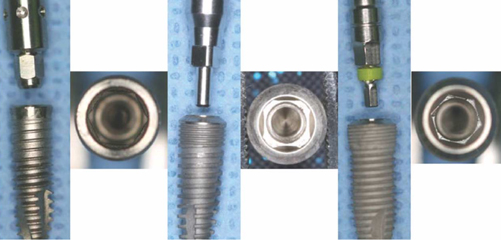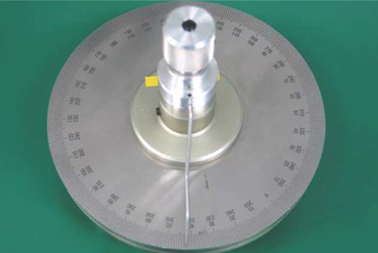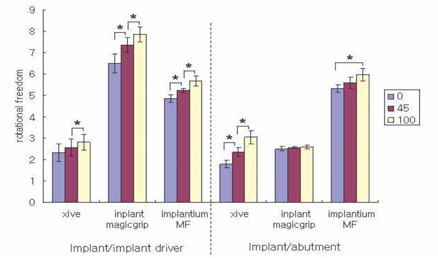J Adv Prosthodont.
2009 Mar;1(1):37-40. 10.4047/jap.2009.1.1.37.
The change of rotational freedom following different insertion torques in three implant systems with implant driver
- Affiliations
-
- 1Department of Prosthodontics, YongDong Severance Dental Hospital, College of Dentistry, Yonsei University, Seoul, Korea. sunjai@yuhs.ac
- 2Department of Dentistry, YongIn Severance Hospital, College of Dentistry, Yonsei University, YongIn, Korea.
- KMID: 2176340
- DOI: http://doi.org/10.4047/jap.2009.1.1.37
Abstract
- STATEMENT OF PROBLEM: Implant drivers are getting popular in clinical dentistry. Unlike to implant systems with external hex connection, implant drivers directly engage the implant/abutment interface. The deformation of the implant/abutment interface can be introduced while placing an implant with its implant driver in clinical situations. PURPOSE: This study evaluated the change of rotational freedom between an implant and its abutment after application of different insertion torques. MATERIAL AND METHODS: Three kinds of internal connection implants were utilized for the current study (4.5 x 12 mm Xive, 4.3 x 11.5 mm Inplant Magicgrip, 4.3 x 12 mm Implantium MF). An EstheticBase, a 2-piece top, a Dual abutment was used for its corresponding implant system. The rotational freedom between an implant and its abutment were measured before and after applying 45, 100 Ncm insertion torque. Repeated measures ANOVA was used for statistical analysis. RESULTS: Under 45 Ncm insertion torque, the rotational freedom between an implant and its abutment was significantly increased in Xive (P = .003). However, no significant change was noted in Inplant Magicgrip and Implantium MF. Under 100 Ncm torque, both in Xive (P = .0005) and Implatium MF (P = .03) resulted in significantly increased rotational freedom between the implant and its abutment. DISCUSSION: The design of the implant/implant driver interface effectively prevented the deformation of implant/abutment interface. Little change was noted in the rotational freedom between an implant and its abutment, even though the insertion torque was far beyond clinical application. CONCLUSIONS: The implant/abutment joint of internally connecting implants were quite stable under insertion torque in clinical situation.
Figure
Reference
-
1. English CE. Externally hexed implants, abutments, and transfer devices: a comprehensive overview. Implant Dent. 1992. 1:273–282.2. Widmark G, Friberg B, Johansson B, Sindet-Pedersen S, Taylor A. Mk III: a third generation of the self-tapping Brånemark System implant, including the new Stargrip internal grip design. A 1-year prospective four-center study. Clin Implant Dent Relat Res. 2003. 5:273–279.3. Bambini F, Memè L, Pellecchia M, Sabatucci A, Selvaggio R. Comparative analysis of deformation of two implant/abutment connection systems during implant insertion. An in vitro study. Minerva Stomatol. 2005. 54:129–138.4. Binon PP. Evaluation of machining accuracy and consistency of selected implants, standard abutments, and laboratory analogs. Int J Prosthodont. 1995. 8:162–178.5. Binon PP. The effect of implant/abutment hexagonal misfit on screw joint stability. Int J Prosthodont. 1996. 9:149–160.6. Binon PP, McHugh MJ. The effect of eliminating implant/abutment rotational misfit on screw joint stability. Int J Prosthodont. 1996. 9:511–519.7. Perriard J, Wiskott WA, Mellal A, Scherrer SS, Botsis J, Belser UC. Fatigue resistance of ITI implant-abutment connectors -- a comparison of the standard cone with a novel internally keyed design. Clin Oral Implants Res. 2002. 13:542–549.8. Cehreli MC, Akça K, Iplikçioğlu H, Sahin S. Dynamic fatigue resistance of implant-abutment junction in an internally notched morse-taper oral implant: influence of abutment design. Clin Oral Implants Res. 2004. 15:459–465.9. Khraisat A, Stegaroiu R, Nomura S, Miyakawa O. Fatigue resistance of two implant/abutment joint designs. J Prosthet Dent. 2002. 88:604–610.10. Merz BR, Hunenbart S, Belser UC. Mechanics of the implant-abutment connection: an 8-degree taper compared to a butt joint connection. Int J Oral Maxillofac Implants. 2000. 15:519–526.11. Norton MR. An in vitro evaluation of the strength of an internal conical interface compared to a butt joint interface in implant design. Clin Oral Implants Res. 1997. 8:290–298.12. de Barros Carrilho GP, Dias RP, Elias CN. Comparison of external and internal hex implants' rotational freedom: a pilot study. Int J Prosthodont. 2005. 18:165–166.13. Squier RS, Psoter WJ, Taylor TD. Removal torques of conical, tapered implant abutments: the effects of anodization and reduction of surface area. Int J Oral Maxillofac Implants. 2002. 17:24–27.
- Full Text Links
- Actions
-
Cited
- CITED
-
- Close
- Share
- Similar articles
-
- Surface change of external hexagon of implant fixture and internal hexagon of abutment after repeated delivery and removal of abutment
- Accuracy of different electronic torque drivers: A comparative evaluation
- The effects of the design of abutment screw driver on the amount of time for insertion of screw driver into abutment screw head
- A study on the compatibility of implant drivers
- Rotational tolerances of a titanium abutment in the as-received condition and after screw tightening in a conical implant connection






